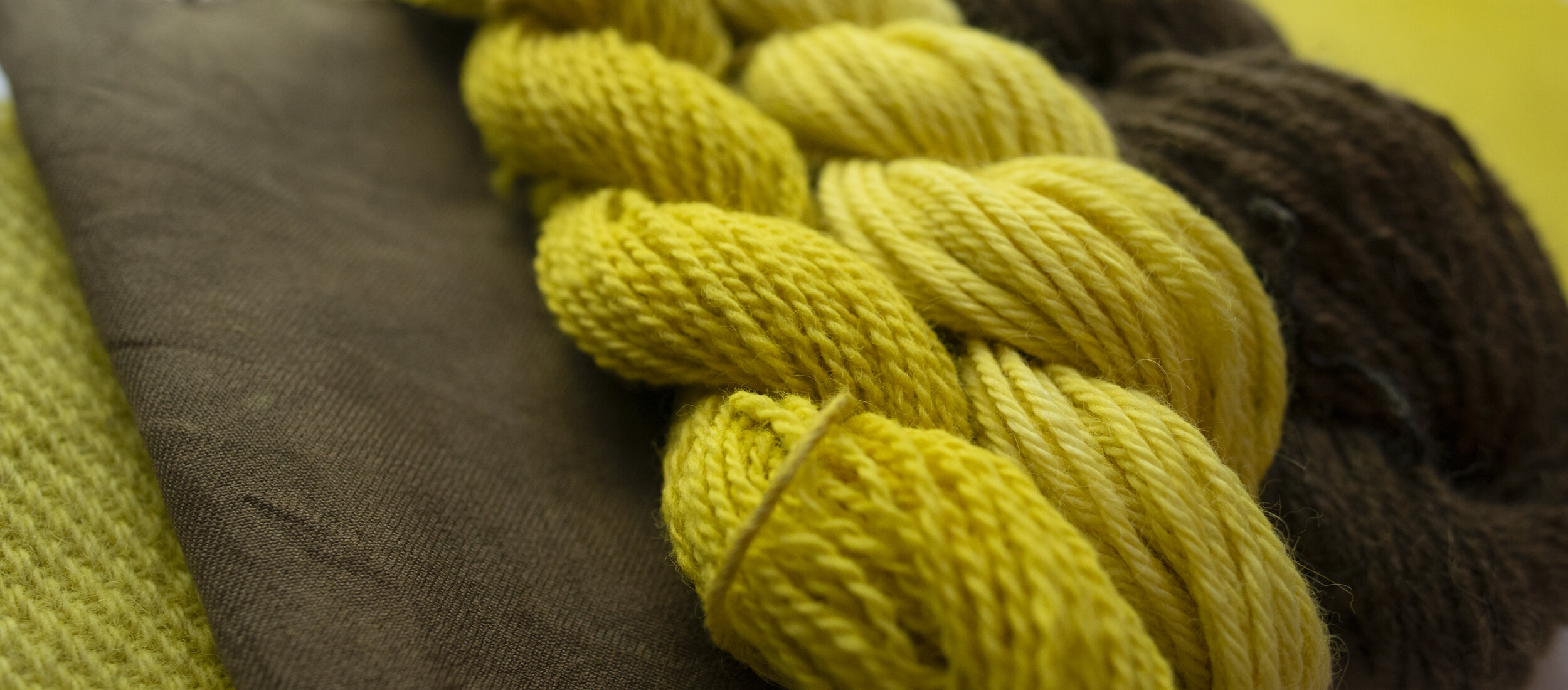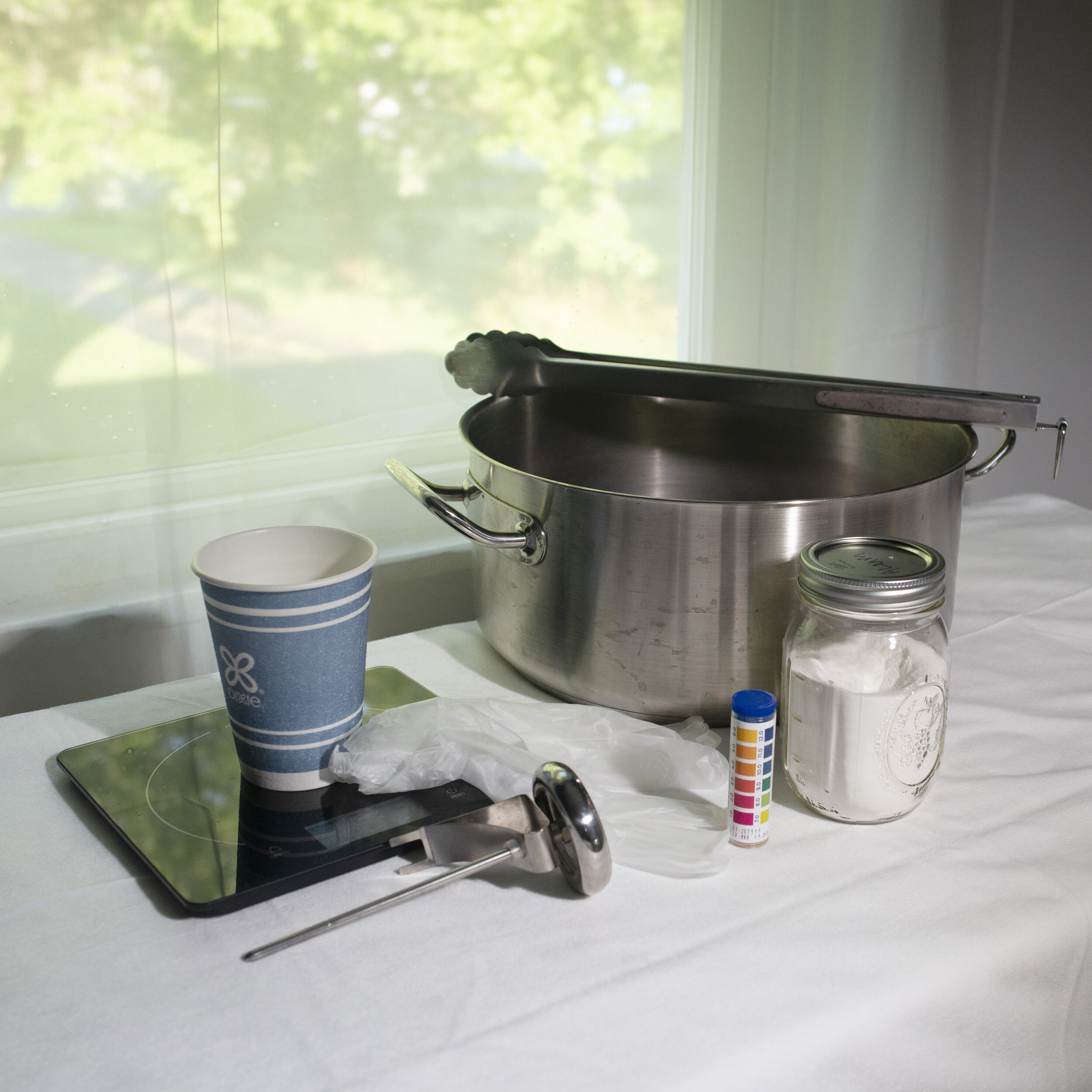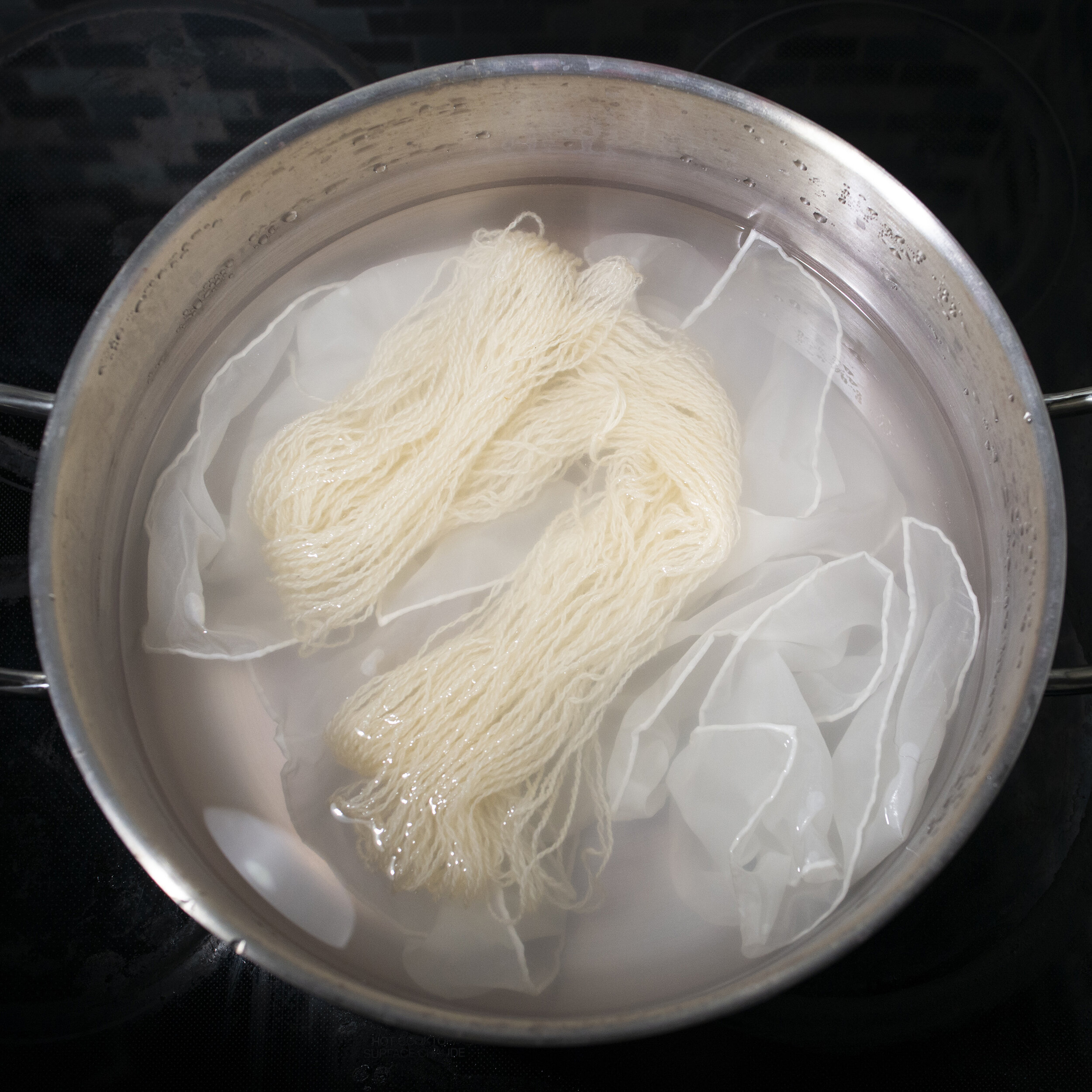
French Weld Extract
A Guide to French Weld Extract
Shepherd Textiles French Weld Extract is made from the yellow flowers of the weld plant, reseda luteola. Weld has been treasured for centuries as the strongest of the natural yellow dyes. The flowers contain a powerful flavonoid called luteolin that gives clear, lightfast yellows. It has a good affinity for all natural fibers, including cotton, which is often difficult to dye. French Weld Extract is produced from flowers grown organically in the Languedoc region of southern France, and it is up to 50% more powerful than weld produced through traditional mass agriculture. Use it at 5% weight-of-fabric for intense, colorfast yellows. Product of France. Produced by a GOTS (Global Organic Textile Standard) certified manufacturer.
1. Background on Weld
The Grand Yellow
Weld, reseda luteola, is a wildflower native to Europe and western Asia. The bright yellow flowers contain a powerful flavonoid called luteolin. Luteolin is an excellent dyestuff, and weld has been celebrated as the best of the natural yellow dyes for many centuries. In France it was known as one of the grande teintes, or one of the “greater dyes,” because it is lightfast and colorfast. France, indeed, was a major center of weld production and export throughout the Medieval and early modern period, until the invention of aniline dyes displaced natural plant dyes in the late 19th century.
Shepherd Textiles French Weld Extract is farmed organically in the Languedoc region of southern France. It is up to 50% stronger than other weld extracts sold for dyeing, and produces strong, clear yellows with just 5% weight-of-fabric. It is an excellent choice for all natural fibers, including hard-to-dye fibers like cotton. It also makes an excellent base for overdyeing with indigo or madder to get greens and oranges.
2. Safety Precautions
DO NOT INGEST. This extract was prepared for textile dyeing, not as an herbal supplement.
Avoid eye contact. If eye contact occurs, rinse with cool water.
Not for use as a cosmetic additive; do not apply directly to skin or hair.
Open carefully to avoid spilling or creating dust.
If a spill occurs, quickly wipe up with a paper towel or disposable rag.
French Weld Extract can permanently dye clothing, countertops, rugs, utensils, or other property. Avoid contact with anything that is not meant to be dyed.
Use only dye pots and utensils dedicated to dyeing. Do not use any pots, containers, spoons, tongs, thermometers, or other utensils that will be used for food preparation.
French Weld Extract, and all dye baths and mordant liquors made while dyeing, should be kept out of reach of children and pets. Use only with adult supervision.
Shepherd Textiles, LLC is not liable for any misuse of this product or any unintended staining of your clothing, workspace, or other property. Use only as directed.
3. Recommended Supplies
Dye pot. Use a dye pot large enough to hold all your fibers, with plenty of room for them to move around and for the liquid to circulate freely. Otherwise, particles of dye may get stuck on the fabric and cause dark splotches.
Metal tongs. A pair of tongs is useful for stirring and taking fabric out. Use tongs dedicated to dyeing, and not for food preparation.
Rubber gloves. Wear rubber gloves while handling extract powder and while handling mordanted/dyed fiber before it is rinsed.
Candy thermometer. The best way to keep track of temperature is to use a candy thermometer that clips to the side of the dye pot.
Scale. Use a scale to weigh out fiber, mordant, and extract powder.
Alum mordant. The alum usually used for mordanting is aluminum potassium sulfate, also known as potash alum. It is the same alum that you can find in a jar in the spice section at the grocery store.
Disposable cup. For mixing the extract powder to a paste.
4. Preparation: Mordanting with Alum
French Weld Extract bonds most effectively to fibers that have been mordanted with alum. For best results, soak your fibers in water for a few hours before mordanting, so that the mordant will penetrate deeply and evenly. Make sure to weigh the fibers first, while they are still dry.
Alum will dissolve quickly into hot tap water.
Heat fibers for an hour at 180F, then allow to cool.
For protein fibers (wool, silk, alpaca, etc.): Mordant at 12% WOF with alum.
Weigh out the fibers you plan to dye (while they are dry). Multiply that weight by 0.12 to get the amount of alum you will need.
Fill your dye pot with hot tap water, leaving enough room for the fiber.
Weigh out the correct amount of alum and pour it into the dye pot. Mix with a spoon or metal tongs until it has dissolved.
Gently place your fibers into the mordanting solution.
Heat mordant bath to 180F and maintain heat for 1 hour. If you don’t have a candy thermometer, you will have to estimate the temperature. At 180F, steam vapor will be rising off the water but it will not be bubbling. If your mordant bath starts to bubble, turn down the heat.
Stir every 15 or 20 minutes to make sure fibers mordant evenly. If they do not, the dye will take better in some places than others.
After an hour, remove from heat and let cool to room temperature. Once cool, you can immediately proceed to rinsing, or you can leave the fibers to steep overnight in the mordant bath. This will improve results, especially when dyeing thick or tightly woven fabrics.
Remove cooled fibers. Wearing rubber gloves, gently squeeze excess mordant solution back into the pot. Rinse briefly in lukewarm water. The fiber does not need to be thoroughly washed, but any excess alum should be rinsed out. Set aside until ready to dye. Keep out of reach of children and pets.
Dispose of mordant solution according to local guidelines.
For cellulose fibers (cotton, linen, etc.): Scour well and treat with a clear tannin before mordanting.
French Weld Extract has a good affinity for cellulose fibers, and it can be applied successfully to cotton even without a tannin pre-treatment. However, treating cellulose fibers with a clear tannin like Sumac Extract will deepen the color and make it much more colorfast.
Scour cellulose fibers well. Traditionally this is done in a highly alkaline soda ash solution. Add 2 tsp of soda ash and 1 drop of dish soap to a 5-gallon dye pot. Add cellulose fibers and heat to 180F-190F for an hour, stirring occasionally. Remove from heat, and when cool enough to handle, rinse and wring out well. Household detergents like Tide© are also alkaline (PH 11), so you can also toss the fiber in a washing machine on a high-temperature cycle with plenty of detergent. This will not clean them nearly as deeply as simmering with soda ash, but it will yield much better results than not scouring at all.
[OPTIONAL] Apply a clear tannin to the scoured fabric: Sumac Extract is the best choice. To use, fill your dye pot with hot water, dissolve 5% WOF of the extract into the dye bath, and simmer for an hour. This process will make the cotton or linen more receptive to alum and lay down a base of color. Be sure to keep the fiber moving around: some tannins have insoluble particles that love to get stuck in fabric, and they can cause splotches later on in the dyeing process. After an hour, let cool, remove fibers, and rinse well.
Mordant with alum as described above for protein fibers.

The Recipes
5. Recipe: Bright Yellow
Weld has been celebrated for centuries as the source of a clear, strong, lightfast yellow. Use French Weld Extract at 5% weight-of-fabric (WOF) on alum-mordanted fiber to get the intense yellow that weld is known for. For paler shades, use 2-3% WOF. Weld gives the strongest colors in a slightly alkaline dyebath between PH 7 and PH 8. It also applies quite quickly with moderate heat—there is no need to push the temperature past 170F, even when dyeing cotton.
Fill your dye pot with warm water, making sure there is enough room for the fabric to move around and for water to circulate freely.
Weigh out 5% weight-of-fabric (WOF) French Weld Extract into a disposable cup (multiply the dry weight of the fabric by 0.05 to get the correct amount of extract).
Add a little hot water to the cup and mix to form a thin slurry. Make sure to break up any clumps of powder, otherwise they may cause splotches on your fiber: you may need to mix quite vigorously to break up some smaller, sticky clumps.
Pour the French Weld Extract slurry into the dyebath and mix well. At this point the dyebath will be a greenish yellow color.
Add your pre-mordanted, wetted fibers to the dyebath.
Raise the temperature to 170°F. Maintain for 1 hour, stirring every 20 minutes or so to make sure everything dyes evenly.
After 1 or 1.5 hours, remove pot from heat and allow to cool to room temperature. You can leave overnight to steep to deepen the color, but be sure there are no solid particles in the dye bath, as these may cause splotches if they come to rest on the fiber.
When finished dyeing, remove the fibers and rinse briefly in lukewarm water to remove any particles of dye. You can either proceed immediately to rinsing with detergent, or hang the fabric up to dry first to help the color set. Make sure to hang it up in the shade somewhere where dripping dye will cause no damage. Direct sunlight may fade the color before it has had time set.
For final rinsing, we recommend using a PH-neutral detergent like Synthrapol, it is designed to wash out loose dye. Follow the manufacturer’s directions for best results. CAUTION: French Weld Extract may bleed if not thoroughly rinsed out after dyeing.
Hang up to dry.
6. Recipe: Olive Green
Iron shifts the color of French Weld Extract toward a ruddy olive green. Iron can be applied as an afterwash, by first dyeing the fibers yellow and then heating them in a solution of 2% weight-of-fabric iron sulfate until the color has shifted. However, for the strongest and most lightfast tones, apply French Weld Extract to fibers pre-mordanted with iron rather than alum. Pre-mordanting with iron is not recommended for soft wool like merino, as it can coarsen and damage the fibers. However, mordanting with iron works well with silk and wool yarns with a heavy twist, like rug warp..
Follow the recipe for “Bright Yellow.” However, instead of using fiber mordanted with alum, use fiber mordanted with iron. To mordant with iron, follow the directions for mordanting in Section 4. However, replace the 12% alum with 2% iron (ferrous sulfate). Heat the mordant bath to 180F for 30 minutes rather than an hour, and do not let the fibers steep overnight—remove them from the mordant bath as soon as they are cool enough to handle. Wearing rubber gloves, rinse the fibers well in lukewarm water to remove any excess mordant, as unbonded iron can corrode fiber.
CAUTION: Iron powder is an irritant and may be harmful if ingested, especially for children and pets. Please read your vendor’s safety sheet (MSDS) before using iron as a mordant. Wear gloves, a mask, and eye protection when handling iron powder, iron mordant baths, and iron-mordanted fibers that are not fully rinsed. Keep iron powder and iron mordant baths out of reach of children and pets. Dispose of the mordant bath according to local regulations.
All images and text are copyright of Shepherd Textiles, LLC. Do not reproduce without permission and attribution.







